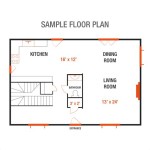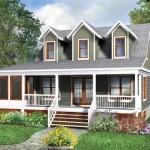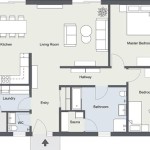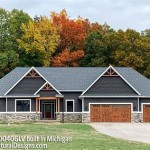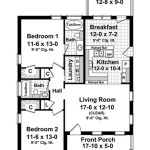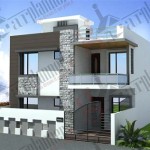Single-Level House Plans With Basement: Maximizing Space and Functionality
Single-level house plans, often referred to as ranch-style homes, are popular for their accessibility and ease of navigation. However, limiting a home to a single story can restrict the overall square footage. A well-designed basement can significantly expand living space without altering the home's exterior footprint. Integrating a basement into a single-level house plan offers numerous advantages, enhancing the home's functionality and potentially increasing its value.
This article delves into the considerations and benefits of single-level house plans with basements, providing insights into design, construction, and suitability for various needs and lifestyles. Understanding these factors is crucial for homeowners considering this type of construction.
Expanding Living Space Affordably
One of the most compelling reasons to incorporate a basement into a single-level house plan is the significant expansion of living space. A basement can potentially double the usable square footage of the home without the added expense of constructing an additional story above ground. This is particularly beneficial in areas where land costs are high or zoning restrictions limit the maximum height of buildings.
The uses for a basement are varied and adaptable to the homeowner's needs. It can serve as a recreation room, home theater, gym, office, guest suite, or even a rental apartment. The flexibility of the space allows homeowners to customize it to suit their lifestyle and evolving needs. Furthermore, finishing a basement is often more cost-effective than adding an above-ground addition because the foundation and basic structure are already in place. This makes it a financially attractive option for expanding a home's functionality.
However, it is crucial to carefully plan the basement's layout and functionality during the initial design phase. Considerations should include adequate lighting, ventilation, and egress options to ensure the space is comfortable and safe. Proper waterproofing is also essential to prevent moisture problems and potential damage to the structure and belongings stored within.
Accessibility and Aging in Place
Single-level homes inherently offer accessibility advantages, eliminating the need for stairs and making them ideal for individuals with mobility limitations or those planning to age in place. The addition of a basement, while seemingly contradictory to the concept of single-level living, can be designed to maintain accessibility. This can be achieved through the installation of an elevator or a stairlift, providing safe and convenient access to the lower level.
Even without specialized accessibility features, a basement can contribute to long-term living flexibility. By relocating specific functions, such as storage or laundry, to the basement, the main living area can be kept more accessible and clutter-free. This can improve maneuverability and reduce potential hazards for individuals with limited mobility. Additionally, a basement can provide a separate living space for caregivers or family members, allowing for independent living arrangements while maintaining proximity and support.
When designing a single-level house plan with a basement for aging in place, it is crucial to consider future needs. This may involve incorporating wider doorways, curbless showers, and other accessibility features in both the main living area and the basement. Thoughtful planning ensures the home remains comfortable and functional throughout all stages of life.
Addressing Site-Specific Challenges
A basement can be a strategic solution for addressing site-specific challenges related to topography, soil conditions, and climate. On sloping lots, a walk-out basement can be incorporated, providing direct access to the outdoors and maximizing natural light and ventilation. This type of basement effectively creates two levels of living space, with the lower level partially submerged and the upper level at ground level.
In areas with expansive clay soils, a basement can provide a stable foundation and protect the home from the effects of soil movement. The foundation walls of the basement act as a barrier, preventing the soil from directly impacting the structure above. This can reduce the risk of foundation cracks, settling, and other structural problems.
In regions with harsh climates, a basement can offer energy efficiency benefits. The earth surrounding the basement walls provides insulation, helping to regulate the temperature and reduce heating and cooling costs. This is particularly advantageous in areas with extreme temperature fluctuations. Furthermore, a basement can serve as a safe haven during severe weather events, providing protection from tornadoes, hurricanes, and other natural disasters.
Proper site analysis and geotechnical investigations are essential when planning a single-level house plan with a basement. These assessments will determine the soil conditions, water table level, and other factors that may impact the design and construction of the basement. Addressing these challenges proactively ensures the long-term stability and functionality of the home.
Design Considerations for Single-Level House Plans With Basements
Designing a single-level house plan with a basement requires careful consideration of various factors to ensure a cohesive and functional living space. The relationship between the main level and the basement should be seamless, with easy access and a logical flow between the two levels. Staircase placement is crucial, as it will determine the accessibility and convenience of the basement. An elevator or stairlift may be necessary for individuals with mobility limitations.
Natural light is often a challenge in basements, so strategies for maximizing daylight penetration should be employed. This may involve incorporating larger windows, window wells, or light tubes. Adequate artificial lighting is also essential to create a comfortable and inviting atmosphere. Furthermore, proper ventilation is crucial to prevent moisture buildup and maintain air quality.
The layout of the basement should be carefully planned to accommodate the intended uses. Considerations should include the placement of walls, doors, and windows, as well as the location of plumbing and electrical systems. Sufficient storage space should be incorporated to keep the basement organized and clutter-free. Finally, the basement should be designed to complement the style and aesthetics of the main level, creating a cohesive and harmonious living environment.
A key aspect of basement design is waterproofing. Effective waterproofing measures are essential to prevent moisture problems and protect the structure from water damage. This may involve applying a waterproof coating to the exterior of the foundation walls, installing a drainage system, and ensuring proper grading around the perimeter of the home. Regular inspections and maintenance are also necessary to identify and address any potential leaks or moisture issues.
Cost Factors Associated with Basement Construction
The cost of constructing a basement can vary significantly depending on several factors, including the size of the basement, the complexity of the design, the soil conditions, and the level of finishing. A partially finished basement will generally be less expensive than a fully finished basement. However, a fully finished basement offers greater functionality and can increase the home's value.
Excavation costs can be significant, especially on sites with challenging soil conditions or limited access. The cost of foundation walls will depend on the materials used and the depth of the basement. Waterproofing measures can also add to the cost, but they are essential to protect the structure from water damage.
Finishing costs will vary depending on the quality of the materials used and the complexity of the design. Flooring, drywall, painting, lighting, and plumbing fixtures are all significant expenses. It is important to obtain multiple quotes from contractors and carefully review the scope of work before making a decision. While it may be tempting to cut corners to save money, it is important to prioritize quality and durability to ensure the long-term value and functionality of the basement.
Homeowners should also consider the potential return on investment when assessing the cost of basement construction. A well-designed and finished basement can significantly increase the home's square footage and value, making it a worthwhile investment for many homeowners. Furthermore, the added functionality and flexibility of the basement can enhance the quality of life for the occupants.
Permitting and Regulations for Basement Construction
Before commencing any basement construction, it is essential to obtain the necessary permits and comply with all applicable building codes and regulations. Local building departments typically require detailed plans and specifications for the basement, including information on the foundation, waterproofing, drainage, and ventilation systems.
Permits are typically required for excavation, foundation work, and any structural modifications to the existing home. Inspections are conducted at various stages of construction to ensure compliance with the building codes. Failure to obtain the necessary permits or comply with the building codes can result in fines, stop-work orders, and other penalties.
In addition to building codes, homeowners may also need to comply with zoning regulations and other local ordinances. These regulations may restrict the size and location of the basement, as well as the types of uses permitted. It is important to research these regulations carefully before beginning any construction work.
Engaging a qualified architect or engineer can help homeowners navigate the permitting process and ensure compliance with all applicable codes and regulations. These professionals can provide expert advice on the design and construction of the basement, ensuring that it meets all safety and performance standards.
Ventilation and Moisture Control in Basements
Proper ventilation and moisture control are critical for maintaining a healthy and comfortable basement environment. Basements are prone to moisture problems due to their below-grade location and proximity to groundwater. Moisture can lead to mold growth, which can pose health risks to occupants and damage the structure of the home.
Effective ventilation helps to remove excess moisture and prevent condensation. This can be achieved through natural ventilation, mechanical ventilation, or a combination of both. Natural ventilation involves opening windows and doors to allow fresh air to circulate. Mechanical ventilation involves using fans or air exchangers to exhaust stale air and bring in fresh air.
Dehumidifiers can also be used to remove excess moisture from the air. These devices work by extracting water vapor from the air and collecting it in a reservoir. Dehumidifiers are particularly useful in basements that are prone to high humidity levels. Sealing cracks and gaps in the foundation walls can help to prevent moisture from entering the basement. This can be done using caulk, sealant, or other waterproofing materials.
Regularly inspecting the basement for signs of moisture problems is also important. This may involve checking for water stains, mold growth, or musty odors. Addressing any moisture problems promptly can help to prevent further damage and protect the health of the occupants.
Lighting Options for Basements
Adequate lighting is essential for creating a comfortable and functional basement environment. Basements often lack natural light, so it is important to choose artificial lighting options that provide sufficient illumination. Recessed lighting is a popular choice for basements because it provides even and unobtrusive lighting. These fixtures are installed flush with the ceiling and can be used to create a variety of lighting effects.
Track lighting is another versatile option for basements. These fixtures consist of a track that is mounted to the ceiling and individual lights that can be positioned along the track. Track lighting allows homeowners to direct light to specific areas of the basement, such as work areas or display areas. Task lighting is essential for areas where specific tasks are performed, such as reading, writing, or crafting. Task lights can be desk lamps, floor lamps, or under-cabinet lights.
Ambient lighting provides overall illumination for the basement. This can be achieved through the use of ceiling fixtures, wall sconces, or floor lamps. Accent lighting is used to highlight specific features of the basement, such as artwork or architectural details. Accent lights can be spotlights, track lights, or wall sconces. Choosing energy-efficient lighting options can help to reduce energy costs and minimize the environmental impact. LED lighting is a popular choice for basements because it is energy-efficient, long-lasting, and provides excellent illumination.

Single Floor House Plans With Basement Elegant E Story 28 Images 1 St One

3500 Sf 4 Bedroom Single Story Home Plan 3 Bath Basement Garage Car Chicago Peoria Springfi Level House Plans

3 Bed Craftsman Ranch Plan With Unfinished Basement Architectural Designs 135021gra House Plans

Versatile Spacious House Plans With Basements Houseplans Blog Com

Ranch Style House Plans With Basement All About Floor And More

Ranch House Plans Traditional Floor

3 7 Bedroom Ranch House Plan 2 4 Baths With Finished Basement Option 187 1149

Don Gardner Walkout Basement House Plans Blog Eplans Com

Ranch Homeplans Walk Out Basement Unique House Plans Floor

Craftsman House Plan With Walk Out Basement 4968

